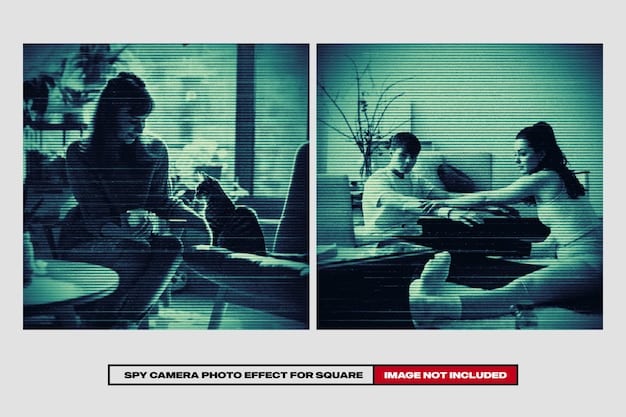Decoding Rotten Tomatoes: A 2025 Guide to Movie Review Scores

Decoding Rotten Tomatoes in 2025 involves understanding how its aggregate scores, combining critics’ and audience ratings, can inform your movie choices while recognizing potential biases and limitations in reflecting overall film quality.
Navigating the world of cinema can be overwhelming, but understanding resources like Rotten Tomatoes can significantly enhance your viewing experience. Decoding Rotten Tomatoes: How to Actually Use Movie Review Scores in 2025 involves much more than just glancing at the Tomatometer; it’s about understanding the nuances of aggregated reviews and audience scores to make informed decisions.
Understanding the Tomatometer in 2025
The Tomatometer is Rotten Tomatoes’ primary feature, representing the percentage of professional critic reviews that are positive for a given movie. However, it’s essential to understand what this percentage truly means and how it can be used effectively in 2025.
The Tomatometer is not an average score. A movie with a 70% Tomatometer score simply means that 70% of the critics reviewed it positively, regardless of how enthusiastic each critic was. A film could receive numerous ratings just above the “fresh” threshold or could receive some perfect ratings but also some very poor ratings. This aggregate of ‘fresh’ versus ‘rotten’ does not reveal the *degree* of the good or bad ratings.
Fresh vs. Rotten: What Do They Really Mean?
A “fresh” rating indicates that a critic generally liked the movie, while a “rotten” rating indicates the opposite. These ratings contribute to the overall Tomatometer score, but understanding the individual reviews provides a more nuanced perspective.
A movie needs at least five reviews to get a Tomatometer score, and 40 reviews for a wide release movie. When 75% or more of reviews for a movie are positive, the movie is Certified Fresh and benefits from special branding across Rotten Tomatoes. To qualify for this designation movies must have been released widely and meet a set threshold for the count of reviews by top critics.
The Importance of Reading Individual Reviews
While the Tomatometer offers a quick snapshot, reading individual reviews provides deeper insights. Critics often highlight specific strengths and weaknesses, giving you a better sense of whether a film aligns with your preferences.
- Genre Preferences: Critics may praise a film for successfully executing genre tropes that you personally dislike.
- Pacing and Tone: Some reviewers may love a movie’s slow burn, while others find it tedious.
- Specific Elements: A reviewer might rave about the acting but critique the script, or vice versa.
By 2025, AI tools may further enhance the ability to summarize and extract key points from numerous reviews, making it easier to grasp the critical consensus efficiently.
Using the Tomatometer alone can be misleading. By cross-referencing this aggregate score with individual reviews, viewers can develop a comprehensive impression of what to expect from any movie.
Audience Scores: A View from the Crowd
In addition to critic reviews, Rotten Tomatoes also aggregates audience scores, providing a general sense of how everyday viewers perceive a film. Understanding these scores is crucial in the context of how movies are now released and consumed online.
Audience scores reflect the percentage of users who have rated a movie 3.5 stars or higher (on a 5-star scale). This score measures overall audience sentiment, and while providing valuable crowd insights, can sometimes differ sharply from professional critic reviews.
Critics vs. Audience: Why the Discrepancy?
Differences between critic and audience scores often stem from varying expectations and criteria. Critics analyze films through a lens of technical skill, storytelling, and originality, while general audiences often prioritize entertainment value and emotional impact.
Cultural relevance and social issues can also cause division: a movie tackling a sensitive topic may be lauded by critics for its bravery and nuance, but is down-rated by audiences who might disagree with the messaging.
Spotting Review Bombing
Review bombing, where groups of users flood a movie with negative reviews for reasons unrelated to its quality, can skew audience scores. Recognizing this phenomenon is crucial for interpreting audience scores accurately.
- Examine the timing of reviews: A sudden surge of negative reviews shortly after release may indicate review bombing.
- Read the reviews themselves: Look for reviews that discuss external factors rather than the movie, or simply use generic negative phrases.
- Cross-reference with other platforms: Check movie ratings on other sites like IMDb or Metacritic to see if the sentiment aligns.
As of 2025, enhanced algorithms can often identify suspicious review patterns. However, viewers still need to approach audience scores critically and contextualize this data alongside all available opinions.
By understanding the reasons behind discrepancies between critic and audience scores, viewers can make more refined judgments about whether they are likely to enjoy a certain film.

The Problem of Score Aggregation
While Rotten Tomatoes effectively aggregates reviews, there are intrinsic limitations in boiling complex reactions down to a single score. This compression can obscure detail and context, potentially misleading viewers.
The core issue lies in the way Rotten Tomatoes simplifies critical assessment into a binary “fresh” or “rotten” judgment. This categorization sacrifices nuance and complexity for the sake of simplicity.
The Nuances Lost in Aggregation
By reducing reviews to positive or negative, Rotten Tomatoes overlooks the spectrum of opinion. A movie deemed “fresh” might still have significant flaws, while a “rotten” movie could possess redeeming qualities.
Even in 2025, viewers must probe deeper to understand the true nature of critical and audience reaction.
Beware of the “Critics Consensus”
Rotten Tomatoes provides a brief “Critics Consensus” summary for each film, intended to encapsulate the main points of praise or criticism. However, this summary can be too simplistic or even misrepresentative.
- Potential for Bias: The consensus may selectively highlight certain aspects of the reviews while ignoring others.
- Vagueness: The summary may use broad generalizations that don’t provide actionable information.
- Outdated Information: The consensus isn’t always updated as new reviews come in, potentially skewing the overall impression.
Therefore, it’s essential to read a variety of reviews and form your own opinion rather than relying solely on the provided summary.
Score aggregation offers convenience, but is no substitute for genuine exploration of diverse opinions. Film enthusiasts should use this tool as an entry point, not as a final answer when deciding whether to invest their time.
The Evolving Landscape of Movie Reviews
The digital age has dramatically changed how we discover and evaluate movies. Understanding these changes is essential for effectively using review aggregators like Rotten Tomatoes.
Movie reviews are becoming more diverse, appearing on personal blogs, YouTube channels, podcasts, and social media platforms. This abundance of sources offers both opportunities and challenges.
The Rise of Influencers and Content Creators
Non-traditional reviewers, such as influencers and content creators, are playing an increasingly significant role in shaping opinions. This can democratize film criticism, but also introduces the risk of bias and lack of expertise.
Many of these voices may receive sponsorship or promotional consideration from studios which can influence the “honest” opinions they share.
Social Media’s Impact on Movie Reviews
Social media platforms provide instant reactions and discussions about movies. While this can create a sense of community and excitement, it also amplifies the potential for misinformation and negativity.
- Hashtag Campaigns: Organized efforts to promote or denigrate a movie can skew perceptions.
- Misleading Trailers: Social media buzz often focuses on trailers, which may not accurately reflect the final film.
- Spoiler Concerns: Real-time discussions can inadvertently reveal key plot points, diminishing the viewing experience.
In 2025, critical consumption of movie reviews involves cross-referencing multiple sources and keeping a watchful eye for manipulated sentiments. The more data you have, the more likely you are to find an accurate assessment.
As the ecosystem of movie criticism evolves, viewers must develop strong media literacy skills to navigate the information overload effectively.

Practical Tips for Using Rotten Tomatoes in 2025
Navigating Rotten Tomatoes effectively requires a strategic approach. By focusing on a combination of scores, individual reviewers, and external sources, viewers can hone their insight and decision making processes.
Don’t let the Tomatometer be your only guide in assessing movies. Viewers seeking to optimize their viewing choices should consider several factors.
Diversify Your Sources
Rather than relying solely on Rotten Tomatoes, consult various sources, including traditional critics, independent bloggers, and trusted content creators. This offers a more balanced overview.
Explore long-form essays, academic film analysis, and audience forums for deeper dives into a film’s themes and artistic merit.
Consider Your Own Preferences
Reflect on your past viewing experiences and identify the types of movies you typically enjoy. Use this knowledge to weigh reviews differently, prioritizing opinions from those who share similar tastes.
- Genre Focus: If you love sci-fi, seek out reviewers who specialize in that genre.
- Director Loyalty: If you admire a specific director, watch their films regardless of aggregate scores.
- Emotional Resonance: Decide what feeling you are seeking in a movie – and choose accordingly.
By 2025 viewers should leverage personalized recommendation systems, aided by AI, that filter and rank content based on individual viewing history and preferences.
Personal enjoyment should always take precedence over aggregated scores. Cultivate an independent approach to movie evaluation, guided by personal experience and intuition.
The Future of Movie Reviews
The way we evaluate movies will continue to change. Emerging technologies like virtual reality and AI will likely transform the ways movies are reviewed, promoted, and consumed.
Virtual reality may allow critics to create immersive reviews, putting viewers inside a simulated version of the film. AI could personalize review recommendations based on viewers’ ever-evolving preferences.
Impact of AI and Machine Learning
AI algorithms could analyze vast amounts of data, identifying patterns and predicting audience reactions with increasing accuracy. This could lead to more personalized and relevant movie recommendations.
Viewers will be able to access “sentiment analysis” reports that reveal viewers’ aggregate emotional responses to movies. AI also offers the chance to identify fake reviews by recognizing bot and troll farms more efficiently.
The Evolution of Immersive Reviews
VR and AR technologies could enable immersive movie reviews, where viewers experience key scenes or environments firsthand. This level of engagement could provide a more visceral and informative assessment.
- Interactive Storytelling: Reviews could allow viewers to explore different plot paths or character perspectives.
- Sensory Experiences: Reviews could simulate the visual and auditory elements of a film, enhancing engagement.
As of 2025, innovations in review technology should be harnessed to provide richer, more insightful evaluations. However, viewers must also remain vigilant against manipulative practices that seek to deceptively shape opinions.
The future of movie reviews is certain to be dynamic, innovative, and increasingly personalized. The challenge lies in harnessing these technologies to enhance, rather than exploit, the movie viewing experience.
| Key Aspect | Brief Description |
|---|---|
| 🍅 Tomatometer | Percentage of positive critic reviews; not an average score. |
| 🍿 Audience Score | Percentage of users who rated the movie 3.5 stars or higher. |
| 🧐 Review Bombing | Massive negative reviews unrelated to movie quality. |
| 🌐 Diversify Sources | Consult various critics, bloggers, and content creators. |
Frequently Asked Questions
▼
A high Tomatometer score only guarantees that a significant percentage of critics viewed the movie positively, not necessarily the degree of enjoyment. It doesn’t assure universal appeal or that you will personally enjoy it.
▼
Review bombing can unfairly lower audience scores, potentially deterring you from watching a good movie. Look for unusual patterns in reviews, and consider critical opinions as well.
▼
No, diversity is important. While established critics offer expertise, independent bloggers and content creators can provide valuable alternative viewpoints, so seek a mix of sources.
▼
AI can personalize recommendations and detect fake sentiments, while VR allows for immersive reviews, allowing viewers to experience scenes firsthand before deciding whether to invest their time.
▼
Use Rotten Tomatoes as a starting point, not the final answer. Consider scores alongside individual reviews, diverse opinions, and your personal preferences to make informed viewing decisions.
Conclusion
Decoding Rotten Tomatoes: How to Actually Use Movie Review Scores in 2025 requires more than a quick glance at aggregated scores. It involves understanding the nuances of both critic and audience reviews, recognizing potential biases, and diversifying your sources of information. By embracing a critical and informed approach, you can navigate the evolving landscape of movie reviews and elevate your viewing experience.





